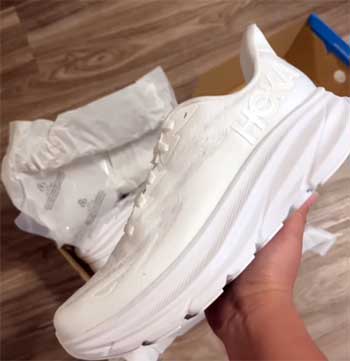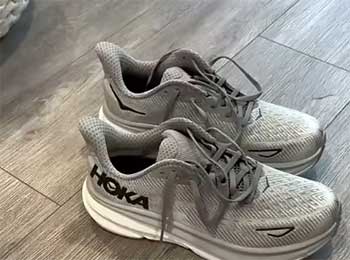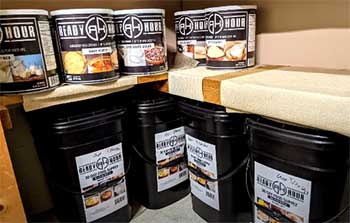As a runner who’s pounded the pavement for years, I’m always chasing the perfect shoe to match my stride, comfort needs, and durability expectations.
In this article, I’m putting the Brooks Ghost Max and HOKA Clifton 9 head-to-head, sharing my firsthand experience to help you decide which shoe fits your running style.
From cushioning to stability, I’ll break down the pros, cons, and key features with a detailed comparison, aiming to guide you toward the right choice for your next run.
A Brief Comparison Table
| Feature | Brooks Ghost Max | HOKA Clifton 9 |
| Weight | 10.1 oz (M), 9.1 oz (W) | 8.7 oz (M), 7.3 oz (W) |
| Heel-to-Toe Drop | 6 mm | 5 mm |
| Cushioning | DNA Loft v2 (Plush, balanced) | CMEVA foam (Responsive, soft) |
| Stack Height | 39 mm (heel), 33 mm (forefoot) | 32 mm (heel), 27 mm (forefoot) |
| Stability | Wide base, GlideRoll rocker | J-Frame, meta-rocker design |
| Fit | Roomy toe box, true-to-size | Narrower fit, slightly snug toe box |
| Breathability | Moderate (engineered mesh) | High (breathable mesh upper) |
| Durability | 400-450 miles | 300-400 miles |
| Price | $150 | $145 |
| Best For | Long runs, recovery, wider feet | Daily training, faster paces, narrow feet |
My First Impressions: Stepping Into The Shoes

Slipping into the Brooks Ghost Max felt like sinking into a cozy couch after a long day.
The plush DNA Loft v2 foam hugged my feet, and the roomy toe box gave my toes freedom to wiggle without feeling sloppy.
At 10.1 ounces for men’s (9.1 for women’s), it’s not the lightest shoe, but it didn’t feel like I was dragging bricks either.
The 6 mm drop and GlideRoll rocker made my strides feel smooth, almost like the shoe was nudging me forward.
The HOKA Clifton 9, on the other hand, greeted me with a springy, lightweight vibe.
At 8.7 ounces for men’s (7.3 for women’s), it’s noticeably lighter, and the 5 mm drop paired with HOKA’s signature meta-rocker design gave me a rolling sensation, like I was gliding through my runs.
The fit was snugger, especially in the toe box, which felt a bit constricting compared to the Ghost Max’s spaciousness. Both shoes screamed quality, but their personalities were distinct—one a supportive hug, the other a peppy bounce.
The Cushioning Clash of Brooks Ghost Max And HOKA Clifton 9
Cushioning is where these shoes flex their muscles, and I put both through the wringer on long runs, recovery jogs, and tempo sessions. The Brooks Ghost Max uses DNA Loft v2 foam, a blend of EVA, rubber, and air that delivers a plush yet balanced ride.
On a 10-mile run through my local park, the cushioning absorbed the impact of each step, especially on uneven paths. It’s not overly squishy like some max-cushioned shoes; instead, it strikes a sweet spot between softness and responsiveness.
I felt protected without losing connection to the ground, which was perfect for my achy knees after a long week of training.
The HOKA Clifton 9, with its CMEVA foam, leans toward a softer, more responsive feel. During a 6-mile tempo run, the cushioning felt lively, almost like it was pushing me to pick up the pace.
The meta-rocker design—a curved sole that promotes smooth transitions—made each stride feel effortless, especially on flat roads. However, on longer runs (think 12+ miles), I noticed the foam compressing slightly, which dulled the bounce compared to the Ghost Max’s consistent plushness.
If you’re chasing a cloud-like ride, the Clifton 9 delivers, but it might not hold up as well for heavier runners or ultra-long distances.
Pros of Ghost Max Cushioning:
- Plush yet balanced, ideal for long runs and recovery.
- Consistent feel over high mileage.
- Great for heavier runners or those needing joint support.
Cons of Ghost Max Cushioning:
- Less responsive than some competitors for speedwork.
- Slightly heavier, which might slow you down on faster runs.
Pros of Clifton 9 Cushioning:
- Lightweight and responsive, perfect for daily training.
- Meta-rocker enhances smooth transitions.
- Soft, cloud-like feel reduces fatigue on moderate runs.
Cons of Clifton 9 Cushioning:
- Foam may compress over time, especially for heavier runners.
- Less plush than max-cushioned options like the Ghost Max.
Stability & Support Comparison of Brooks Ghost Max And HOKA Clifton 9

As someone who occasionally overpronates, stability is a big deal for me. The Brooks Ghost Max surprised me with its inherent stability, thanks to a wide platform and the GlideRoll rocker.
On a trail run with loose gravel, the broad base kept me grounded, and the rocker geometry smoothed out my transitions without feeling rigid.
The shoe doesn’t use Brooks’ GuideRail technology (found in models like the Glycerin GTS), but it didn’t need to—I felt secure even on uneven terrain.
This makes it a solid pick for runners with wider feet or those needing extra support without a clunky stability shoe.
The HOKA Clifton 9 takes a different approach with its J-Frame technology, which cups the heel to prevent excessive rolling.
On a 5K run with some sharp turns, the J-Frame and meta-rocker worked together to keep my foot centered, though the narrower fit made me wish for a wider version (HOKA does offer one, thankfully).
The Clifton 9’s stability shines for neutral runners or mild overpronators, but if you need heavy-duty support, it might feel less secure than the Ghost Max. I loved the Clifton’s lively feel, but I noticed my calves working harder due to the lower 5 mm drop compared to the Ghost Max’s 6 mm.
Pros of Ghost Max Stability:
- Wide platform enhances natural stability.
- GlideRoll rocker promotes smooth, controlled strides.
- Ideal for mild overpronators or heavier runners.
Cons of Ghost Max Stability:
- Heel counter feels stiff, which might irritate some runners.
- Less agile for quick direction changes or speedwork.
Pros of Clifton 9 Stability:
- J-Frame provides subtle, effective support for neutral runners.
- Meta-rocker aids fluid transitions, great for cadence.
- Lightweight design enhances agility.
Cons of Clifton 9 Stability:
- Narrower fit may feel unstable for wider feet.
- Less supportive for severe overpronators.
Fit And Comfort: Finding The Perfect Feel

Fit can make or break a running shoe, and I’m picky about how my shoes hug my feet. The Brooks Ghost Max won me over with its roomy toe box, which let my toes splay naturally—a godsend for my slightly wider feet.
The engineered mesh upper is soft and molds to your foot, though it’s not as breathable as I’d like in hot weather. On a muggy 8-mile run, my feet felt a bit warm, but the cushioned collar and tongue kept things comfy with no hot spots or rubbing. The Ghost Max fits true to size, and I didn’t need to size up, which is rare for me with Brooks.
The HOKA Clifton 9, by contrast, has a snugger fit, especially in the toe box. If you have narrow feet, this might be a dream, but my wider forefoot felt slightly cramped. I tried the wide version, which helped, but it’s still not as roomy as the Ghost Max.
The breathable mesh upper kept my feet cooler during a sunny 10K, and the padded heel counter locked my heel in place without irritation. The Clifton 9’s fit encourages a more natural midfoot strike, which I appreciated for faster runs, but it took a few miles to adjust to the lower drop.
Pros of Ghost Max Fit:
- Spacious toe box, great for wider feet or toe splay.
- True-to-size fit with a comfy, secure upper.
- Accommodates foot conditions like bunions or hammertoes.
Cons of Ghost Max Fit:
- Less breathable in warm conditions.
- Stiff heel counter may feel restrictive for some.
Pros of Clifton 9 Fit:
- Snug, secure fit ideal for narrow feet.
- Highly breathable mesh upper for hot runs.
- Heel lock lacing option enhances fit customization.
Cons of Clifton 9 Fit:
- Narrow toe box may cramp wider feet.
- Lower drop may strain calves for heel strikers.
Durability of Brooks Ghost Max And HOKA Clifton 9

I’m not made of money, so I want shoes that can handle serious mileage. The Brooks Ghost Max impressed me with its robust build.
The DNA Loft v2 foam held up well after 100 miles of mixed running, showing minimal creasing or compression.
The outsole, made of solid rubber, gripped well on dry pavement and light trails, with only slight wear after a month of use.
Experts estimate a lifespan of 400-450 miles, which aligns with my experience, making it a reliable choice for runners logging high weekly miles.
The HOKA Clifton 9, while durable, didn’t quite match the Ghost Max’s longevity. The CMEVA foam started showing slight compression after 80 miles, especially under my heavier frame (180 lbs).
The outsole, with added rubber in high-wear areas, held up decently, but I noticed more wear on the medial side compared to the Ghost Max. Runners report 300-400 miles of life, which is solid but shorter than the Ghost Max, especially for heavier runners or those on abrasive surfaces.
Pros of Ghost Max Durability:
- Long-lasting DNA Loft v2 foam resists compression.
- Durable outsole handles varied terrains.
- Ideal for high-mileage runners.
Cons of Ghost Max Durability:
- Slightly heavier build may wear faster for speedwork.
- Less grip on wet surfaces.
Pros of Clifton 9 Durability:
- Decent lifespan for a lightweight shoe (300-400 miles).
- Strategic rubber placement enhances outsole durability.
- Holds up well for daily training.
Cons of Clifton 9 Durability:
- Foam compresses faster than Ghost Max, especially for heavier runners.
- Less durable on rough or abrasive surfaces.
Also Read: Comparison of HOKA Rincon 3 And Clifton 8 Shoes.
Performance: How They Handle the Road?
I tested both shoes across various runs—long, slow jogs, tempo runs, and even some light trail adventures. The Brooks Ghost Max was my go-to for recovery runs and long, easy miles.
On a 15-mile run, the plush cushioning and stable platform kept my legs fresh, and the rocker geometry made transitions feel effortless. It’s not built for speed, though; during a 5K at a faster pace, the extra weight (10.1 oz) held me back compared to lighter shoes.
The HOKA Clifton 9 shone on daily training runs and tempo sessions. Its lightweight build and responsive foam made a 7-mile run at a 7:30/mile pace feel snappy, and the meta-rocker kept my cadence quick.
However, on a 12-mile run, I felt the cushioning lose some of its spring, and the narrower fit made my feet ache slightly. It’s versatile but leans toward shorter, faster runs over marathon distances.
Pros of Ghost Max Performance:
- Excellent for long, slow runs and recovery.
- Stable for varied terrains, including light trails.
- Smooth transitions thanks to GlideRoll rocker.
Cons of Ghost Max Performance:
- Too heavy for speedwork or races.
- Less responsive for quick, agile movements.
Pros of Clifton 9 Performance:
- Lightweight and responsive for daily training and tempo runs.
- Meta-rocker promotes fast, efficient strides.
- Versatile for mixed paces and distances.
Cons of Clifton 9 Performance:
- Less comfortable on very long runs due to foam compression.
- Narrow fit may limit stability on uneven terrain.
Price And Value Comparison of Brooks Ghost Max And HOKA Clifton 9
At $150, the Brooks Ghost Max is a touch pricier than the HOKA Clifton 9 at $145. For me, the Ghost Max’s durability and plush comfort justify the extra $5, especially if you’re a high-mileage runner or need a shoe for recovery and long runs.
It’s a workhorse that delivers consistent performance, making it a great value for those prioritizing longevity and support.
The Clifton 9, at $145, offers excellent value for runners seeking a lightweight, versatile daily trainer. Its slightly shorter lifespan is offset by its responsive feel and breathability, making it a solid choice for those who mix up their runs or live in warmer climates.
Both shoes are competitively priced, so your choice hinges on your running needs rather than a significant cost difference.
Pros of Ghost Max Value:
- Long lifespan (400-450 miles) maximizes investment.
- Versatile for various activities, from running to walking.
- Great for runners needing support and comfort.
Cons of Ghost Max Value:
- Slightly higher price than Clifton 9.
- Less appealing for speed-focused runners.
Pros of Clifton 9 Value:
- Competitive price for a lightweight, versatile shoe.
- Ideal for runners prioritizing responsiveness and breathability.
- Wide version available for better fit options.
Cons of Clifton 9 Value:
- Shorter lifespan (300-400 miles) than Ghost Max.
- Narrow fit may require sizing up or wide version.
Who Are These Shoes For?
The Brooks Ghost Max is my pick for runners who crave plush comfort and stability for long runs, recovery days, or even walking. Its roomy fit and durable build make it ideal for heavier runners, those with wider feet, or anyone needing extra joint support (like me with my occasional knee pain). It’s also a great choice for beginners or casual runners who want a reliable, no-fuss shoe.
The HOKA Clifton 9 suits runners who want a lightweight, responsive shoe for daily training, tempo runs, or shorter distances. Its meta-rocker and breathable upper make it a favorite for neutral runners with narrower feet or those chasing a faster cadence.
If you’re an ultrarunner or prefer a softer, more maximalist feel, you might lean toward HOKA’s Bondi instead.
Which Shoe Wins?
After weeks of testing, I’m torn but leaning slightly toward the Brooks Ghost Max. Its plush cushioning, roomy fit, and durability won me over for long runs and recovery days, especially since my wider feet and achy joints need extra love.
The HOKA Clifton 9, though, is a close second—its lightweight, responsive ride made my faster runs feel effortless, and the breathability was a lifesaver in warm weather. Your choice depends on your priorities: go Ghost Max for comfort and longevity, Clifton 9 for speed and agility.
Also Read: Comparison of Hoka Mach 5 And Clifton 9 Shoes.
Frequently Asked Questions (FAQ)
It depends on your needs. The Brooks Ghost Max offers plush comfort and durability for long runs and recovery, ideal for wider feet or heavier runners. The HOKA Clifton 9 is lighter and more responsive, great for daily training and faster paces, especially for narrower feet.
HOKA Clifton 9 runs snugger, with a narrower toe box, best for narrow feet or those who size up or choose the wide version. Brooks Ghost Max has a roomier toe box and true-to-size fit, accommodating wider feet or conditions like bunions.
The Clifton 9 excels as a lightweight daily trainer for neutral runners. It’s ideal for daily runs, tempo sessions, and shorter distances (5K to half-marathon), offering responsive cushioning and a meta-rocker for smooth, fast strides.
Both help with knee pain, but the Brooks Ghost Max’s plush DNA Loft v2 cushioning and stable platform may offer better impact absorption for joint relief. The HOKA Clifton 9’s softer foam and meta-rocker also reduce stress, but its narrower fit may not suit everyone.
Conclusion: Your Run, Your Choice
You’re now armed with the full scoop on the Brooks Ghost Max and HOKA Clifton 9, straight from my feet to your screen. If you’re like me, craving a plush, durable shoe for long hauls or recovery, the Ghost Max might be your soulmate.
Prefer a lighter, snappier ride for daily training or tempo runs? The Clifton 9 could be your go-to. Test them if you can, and let your feet decide—you won’t go wrong with either. Happy running!

